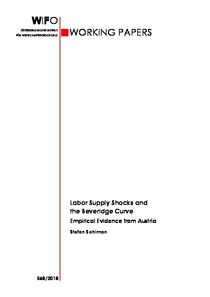Labor supply shocks and the beveridge curve. empirical evidence from Austria
"Austria's Beveridge Curve has shifted markedly outwards since labor market access for Eastern European neighbors was liberalized in 2011. I quantify the effects of labor supply shocks by means of a structural VAR with sign restrictions, distinguish domestic-worker from foreign-worker shoc...
| Main Authors: | , |
|---|---|
| Institution: | ETUI-European Trade Union Institute |
| Format: | TEXT |
| Language: | English |
| Published: |
Vienna
2018
WIFO |
| Subjects: | |
| Online Access: | https://www.labourline.org/KENTIKA-19390636124911188189-Labor-supply-shocks-and-the-be.htm |
| Summary: | "Austria's Beveridge Curve has shifted markedly outwards since labor market access for Eastern European neighbors was liberalized in 2011. I quantify the effects of labor supply shocks by means of a structural VAR with sign restrictions, distinguish domestic-worker from foreign-worker shocks and find that the latter contributed considerably to the counter-clockwise outward movement. On impact, the arrival of additional job seekers facilitates matching but it lowers the chance for existing job seekers to be matched, raising employment and unemployment simultaneously. In the medium run vacancies increase, the employment surge accelerates and unemployment declines. Labor supply shocks caused by foreigners have an unambiguous and positive effect on domestic employment in the long run, indicating complementarity between foreign and domestic labor. On a regional level Vienna, the capital in the east of the country, was most heavily exposed to the recent labor immigration boom." |
|---|---|
| Physical Description: | 24 p. Digital |

